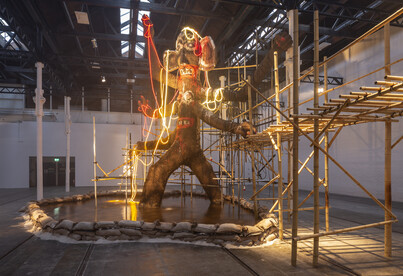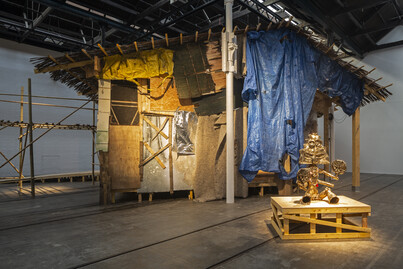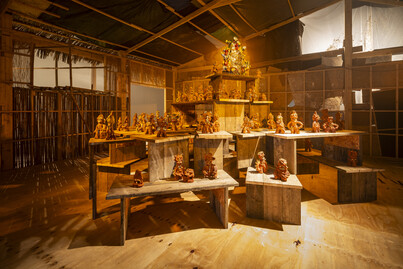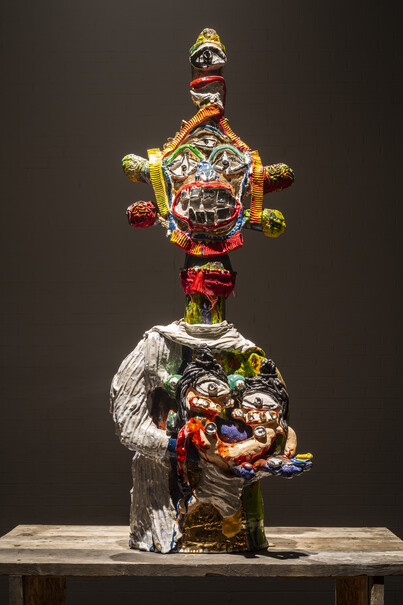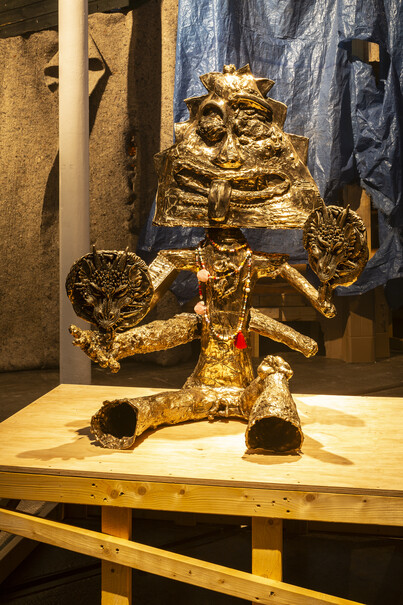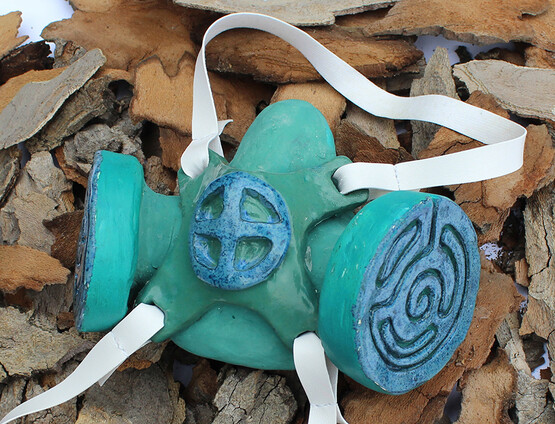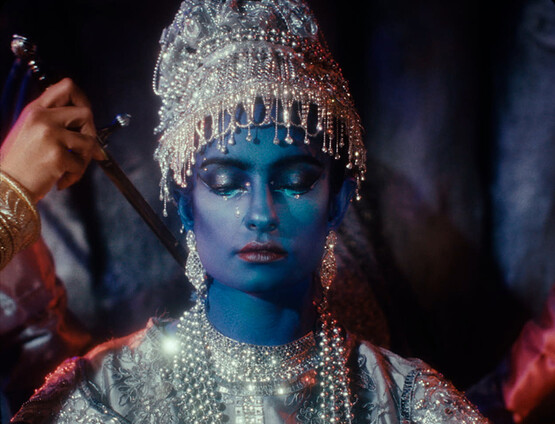
Queer ecologies of abundance
by Edwin Coomasaru
Reviews /
Exhibition
• 21.12.2023
At the centre of Idols of Mud and Water by Ramesh Mario Nithiyendran (b.1988) at Tramway, Glasgow, is an imagined multi-gendered deity, which is both earthly and otherworldly. Multi Limbed Mud Fountain FIG.1 is made of cob, an ancient building material, and stands in a muddy pool ringed by flood-prevention sandbags. Reams of cascading neon and electric cabling hang from its five arms and dip into the liquid below; water gushes out from various pipes embedded in its body. Scaffolding is assembled around the statue, crafted to create an impression of workers having temporarily put down their tools.1 The fountain is illuminated by stage-set lighting, which pierces through the clouds of fog that shroud its mythic form. The artist has spoken of the entrances to temples and sacred sites as places ‘where something greets and confronts you and tells you you’re entering another reality’.2 Recent decolonial and Marxist writing has argued that the planet has abundant resources, but they require redistribution rather than unequal accumulation.3 Multi Limbed Mud Fountain is at once deeply attentive to the current climate breakdown, with its roots in environmental exploitation by European colonialism, and also invites viewers into abundant worlds.
Nithiyendran’s life, work and exhibition connect three countries: Sri Lanka, where the artist was born; Australia, where he relocated to during the Sri Lankan Civil War (1983–2009); and Scotland, where the show is currently on display.4 After the British invasion of Sri Lanka in 1796, 1815–1948 was the only period in which the entire island was ruled by a European power. Common land, invested with spiritual knowledge and used for subsistence living, was deemed a ‘waste’ by the British.5 Planters replaced such spaces with mass tea or coffee plantations, which extracted produce and profits back to the United Kingdom, laboured largely by migrant Tamil workers from South India. Colonial control over the island’s ecology was interconnected with attempts to manage its population via the regulation and restriction of sexuality. The Vagrants Ordinance of 1841 forbade public soliciting or indecency, before homosexuality was outlawed in Sri Lanka for the first time as ‘against the order of nature’ by the 1883 Penal Code.6 British colonisers fretted that they could not tell Sri Lankan men and women apart, while race science claimed greater sexual dimorphism was a sign of white superiority.7 Homosexuality as an identity category was a nineteenth-century concept, created in the Global North and spread through imperial networks: Buddhist and Hindu understandings of sex did not have the same association with sin nor organisation of desire.8
Alongside a different framework for understanding gender and sexuality, Sri Lankan culture also had distinct ways of viewing the island’s environment: folklore told of abundant spiritual landscapes, to be used on the basis of need rather than over-exploitation.9 The theorist Silvia Federici has pointed out that capitalism began in Europe with the enclosure of common land, persecution of paganism and prohibition of non-normative sexualities.10 Similar practices took place in nineteenth-century Sri Lanka, where Christian missionaries tried to suppress Buddhism in an effort to create ‘a second Eden’.11 Such historical contexts inform the background for Nithiyendran’s installation in Glasgow. Sri Lanka was colloquially called a ‘Scotch colony’ for its networks of Scottish planters, with a region of plantations in the island’s central highlands renamed ‘New Scotland’ and described as having ‘a cold Scotch mist’.12 As Scotland reassesses its own role in the British Empire, including its public monuments and looted artefacts, Nithiyendran’s exhibition presents a powerful reckoning and otherworldly portrait. The threat of real or mythic floods suggested by Multi Limbed Mud Fountain evoke an ‘end-times’ vision. Both Idols of Mud and Water and apocalypticism as a cultural discourse contain contradictions: beginnings and endings, annihilation and revelation, utopia and dystopia.
A bamboo walkway runs from Multi Limbed Mud Fountain to a large temple-like structure with a distinct South-East Asian architectural vernacular FIG.2. The building is patched together with tarpaulin, corrugated iron and wood sourced locally from Glasgow, either recycled or new but made to appear used.13 Inside are ninety-seven small spot-lit terracotta figures positioned in a pyramid formation FIG.3, inhabiting a symbolic sacred space or post-apocalyptic shelter. Arranged around the perimeter of the installation are other multi-gendered deity statues, cast in bronze or glazed ceramic and poised on reclaimed industrial-looking wooden plinths. In Multiheaded Figure in Drapery (King) FIG.4, three brightly coloured stacked heads sprout skywards out of the torso’s neck. Fine drapery alludes to Gandhāran visual culture, which combined aspects of ancient Greek and Buddhist art, after the queer monarch Alexander the Great’s invasion of the Indian subcontinent in 327–25 BC.14 Nineteenth-century homoerotic European accounts later objectified Sri Lankan men by likening them to Greek sculptures in ‘Edenic’ landscapes.15 Other works of art in the show also consider the impact of European colonialism on the island’s cultural imagination. Fertility Figure with Drapery (Queen) FIG.5 features exaggerated eyes and teeth perched on an elongated neck, with its arms cradling two conjoined child-like forms. The statue references mythic maternal figures, including the Virgin Mary. Christian iconography was mixed with Buddhist and Hindu imagery on Sri Lankan ivory casket carvings, a response to Portuguese (1505–1658) and Dutch (1640–1796) coastal colonialism.16
Nithiyendran draws attention to these periods and processes of aesthetic exchange and syncretism to explore the underlying power dynamics at play. The show critically reflects on the way European imperialism produced modern ideas of gender, sexuality and race to intervene in land relations.17 The activist and writer Harsha Walia has argued that geopolitical borders are a structural tool of capitalist colonialism, which work through a hierarchical ordering of identity categories.18 She insists on the need to ‘weave solidarities through the lens of abundance, rather than scarcity, and celebrate the interdependence’.19 Similarly, Idols of Mud and Water calls for generous forms of collective being in the midst of climate breakdown. The gender and sexuality studies scholar Anjali Arondekar describes abundance as a joyful, creative and playful practice that stages a mix of fact and fiction through a disorderly excess of materials, unrestrained by exclusionary concepts of belonging.20 Nithiyendran’s sculptures have a painterly quality, as though their forms are gelatinous and soft, almost verging on liquidity, which seems to ooze from object to object. For Seated Bronze Figure with Masks FIG.6, the artist employed the lost-wax casting technique, reusing moulds from previous works of art in order to assemble a composite creature with clearly visible seams. The conglomeration is adorned with details cast into the bronze: Styrofoam protrusions, as well as plastic toys produced from fossil fuel-based chemicals.
The installation either involves or implies recycling as an aesthetic – a practice that is both environmentally conscious and perhaps also suggests a kind of queer sensibility. From the eighteenth century, European heteronormativity has historically positioned non-procreative sexualities as wasteful.21 Idols of Mud and Water reclaims and reimagines materials and objects considered by some to be refuse and repositions them as brimming with vital life forces as they adorn or house multi-gendered figures. Where British colonialism once enclosed and extracted Sri Lanka’s environment, attempting to shatter its spiritual power and manufacture ecological scarcity, Nithiyendran presents a vision of abundant landscapes animated by divine powers. At a time when the original 1883 Penal Code outlawing homosexuality as ‘against the order of nature’ is being amended by the Sri Lankan Parliament, Idols of Mud and Water crafts a queer aesthetic in which supernatural beings inhabit genders beyond a binary model.22 Mixing fact and fiction, referencing real and imagined South-East Asian deities, alongside ancient sculpture and kitsch consumerism, the exhibition is a playful exercise in world-building, in which the seams and the staging are made explicit. Idols of Mud and Water presents a joyful and generous invitation to abundant worlds.




